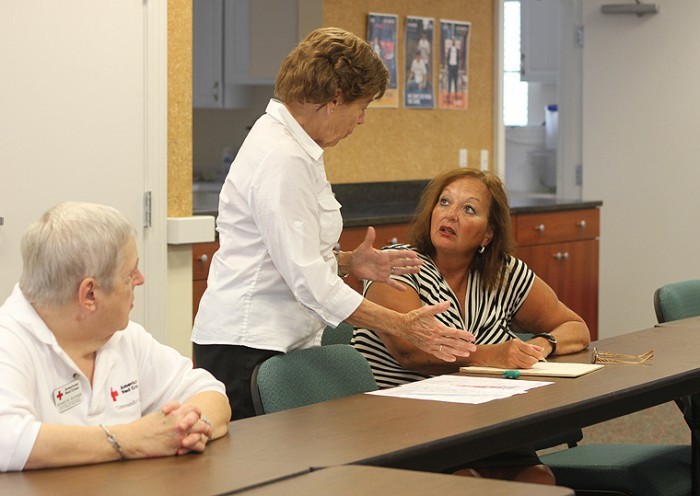
VERO BEACH — The American Red Cross and the Abilities Resource Center (ARC) sponsored a workshop on emergency preparedness at the United Way of Indian River County office on Wednesday.
Administrators from both organizations gave advice on everything from what canned items to put in a storm survival kit to which shelters were special needs-friendly.
Of the 14 emergency shelters in Indian River County, only one is categorized as a special need shelter – Treasure Coast Elementary in Sebastian.
There is only one pet-friendly shelter, located at Liberty Magnet School in North County.
The other 12 shelters are:
• Sebastian Elementary, 400 Sebastian Blvd, Sebastian
• Fellsmere Elementary, 50 N. Cypress St, Fellsmere
• Sebastian River Middle, 9400 County Road 512 Sebastian
• Sebastian River High School, 9001 90th Avenue, Sebastian
• Pelican Island Elementary, 1355 Schumann Drive, Sebastian
• Gifford Middle, 4530, 28th Court, Vero Beach
• Vero Beach High School Freshman Learning Center, 1507 19th St, Vero Beach
• Vero Beach High School, 1707 16th St, Vero Beach
• Glendale Elementary, 4940 8th St, Vero Beach
• Oslo Middle, 480 20th Ave SW, Vero Beach
• Thompson Lifelong Learning Center, 1110 18th Ave SW, Vero Beach
• Highlands Elementary, 500 20th St SW, Vero Beach
Organizers of the workshop noted that not every shelter would be necessarily open in the event of a storm. Open shelters would be listed on emergency broadcasts via local radio and TV.
Not everyone needs to head for a shelter in the event of a category-three hurricane, however. The advent of improved building codes, hurricane shutters and hurricane glass now allow people to take shelter from all but the very worst hurricanes, organizers said during the workshop.
“We really advocate, if possible, that people shelter within their own homes,” said Sharon Rayner, Director of Emergency Services of the North Treasure Coast Chapter of American Red Cross. “One of the things we preach is to stay informed. If your home has hurricane-rated shutters and is built to recent building codes, you are in a very safe environment. If it gets above a category three, then the shelter is a pretty good place for you. But below that, I would say it is your home, which is probably the best and most comfortable place for you to be.”
Shelters are good places for people who live in manufactured homes or dwellings of similar construction. It is important to know about the space limitations before checking into a shelter, though, and to know which shelters cater to people with special needs.
“The special needs shelter is much more enhanced with electrical generation for medical equipment and for air conditioning for those who can’t live without it,” said Mary Ellen Lewis, health service lead for the North Treasure Coast Chapter of American Red Cross.
This doesn’t mean the special needs shelter is anything like a resort, though. Space is tight even in this shelter, they said.
“The public doesn’t realize special needs and the elderly only get 20 square feet of space,” said Heather Dales, Chief Operating Officer at ARC of Indian River County. “If you were to take about two and a half feet by six and a half feet, that is about all of the space you would have if you went to an emergency shelter. It’s not a lot of space, so when you start looking at emergency placement or services, and how many people will be there. That’s your space for one day, two days, three days, or however long a hurricane lasts because this is a short-term emergency setting. This is not a long-term shelter.”
The Centers for Disease Control and Prevention recommends you stock your home with supplies that may be needed during an emergency period. These supplies should, at a minimum, include:
• Several large, clean containers to store a three to five-day supply of water.
• A first-aid kit and manual.
• A battery-powered radio, flashlights, and extra batteries.
• Sleeping bags or extra blankets.
• Water-purifying supplies, such as chlorine or iodine tablets or unscented, ordinary household bleach.
• Prescription medicines and special medicine needs.
• Baby food and/or prepared formula, diapers, and other baby supplies.
• Disposable cleaning cloths, such as “baby wipes” for the whole family to use in case bathing facilities are not available.
• Personal hygiene supplies, such as soap, toothpaste, sanitary napkins, etc.
• An emergency kit for your car with food, flares, booster cables, maps, tools, a first-aid kit, fire extinguisher, sleeping bags, etc . . .
It is also important to remember to keep a manual can opener handy in the event of loss of electricity.
For more information on emergency plans and supply kits, visit http://www.ready.gov



